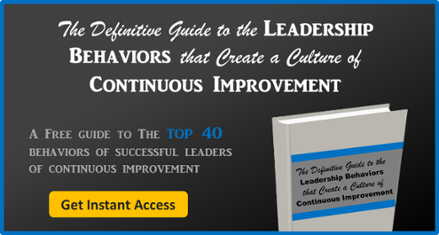
A successful business today understands the value of both improvement and innovation, and it knows that while these terms may have different meanings, they are equally critical for long-term business success. Organizations that embrace both methods of increasing business value are the ones that will not only survive, but thrive in today’s competitive marketplace.
What’s the difference between innovation and improvement?
Improvements are small, incremental changes that make a business’s goods or services better in some way, whether by reducing cost, increasing value, improving safety, or enhancing quality or satisfaction. They’re typically low-cost, low-risk ideas that can be implemented by the people doing the work all day, every day. Improvements start with examining a current process and asking the question:
“How can I do this better?”
Organizations that successfully use improvements to better their business processes embrace a bottom-up organizational improvement methodology.
A business process improvement example is organizing a supply room in order to save employees’ time in searching for supplies. In addition, a simple improvement like organization can save the organization money by reducing overstocking costs and rush orders. This improvement would take the status quo - stocking supplies in a single location, to be retrieved as-needed by employees - and improve the process to increase efficiency and improve the bottom line.
Innovation, on the other hand, starts with the status quo and asks:
“How can I do this in a whole new way, to achieve significantly better results?”
Innovative ideas are ground-breaking, far-reaching, significant changes to business processes that serve the purpose of improving the organization in wide swaths. Because they are generally more impactful, innovations are typically more difficult to implement; they require more analysis before they can get approval from leadership, which creates a greater barrier to implementation.
These barriers mean that fewer innovations are implemented typically, though their significant impacts make them a valuable aspect of business process improvement. Innovations are usually part of a top-down approach to improvement, with ideas passed down from leadership to be planned and implemented by lower-level staff.
Examples:
Improvement: Create better signage in a hospital emergency room showing where restaurant and washroom facilities are located.
Innovation: Install a software program as part of the hospital network that automatically senses customer smart phones and sends an automated welcome message showing a map of the facility and providing free coffee when the customer shows their smartphone to the reader in the restaurant. This innovation helps tracks the movement of customers through the emergency facility to enable improved flow.
For more business process improvement examples, check out this post on the KaiNexus Blog: 3 Thought-Provoking Business Process Improvement Examples.
SalesForce, Inc. has been named the “world’s most innovative company” by Forbes Magazine for the past four years, a designation that means investors feel SalesForce is the most likely of over 500 businesses to come up with the next ground-breaking innovation. How did they achieve that phenomenal success and become such a shining business process improvement example?
CEO Marc Benioff says attributes it to a stellar combination of
Essentially, SalesForce has taken a consistently innovative product and combined it with employee engagement in continuous improvement. This gives SalesForce the edge over the competition, and then keeps them at the top by empowering employees to make continuous improvements.
Organizations that are able to thrive like SalesForce in today’s competitive business market do so because they successfully engage their staff and leaders in implementing both bottom-up improvements and top-down driven innovations. These two critical elements are equally important in improving business processes. Both innovation and improvement thrive in organizations that foster a community of collaboration in a culture that encourages idea sharing, both supporting successes and allowing failures.
Actively Support Leadership
Creating a successful and sustainable culture of continuous improvement and innovation requires ongoing, active involvement of leaders at all levels. Leaders must understand the importance of both process improvement and innovation, and they must encourage staff engagement at every available opportunity. This means allowing employees to spend time working on innovation and improvement, and supporting their successes as well as encouraging learning from failure.
Engaged Employees
Creating an engaged workforce is important, because these are the people who are most likely tobe able to identify appropriate, impactful opportunities for improvement. A successful business recognizes their employees’ collective power for improvement, and it finds way to harness that potential to create positive change for the company.
Read this free eBook for more info on how to engage your employees!
An Improvement Methodology
Organizations should ensure that everyone has a basic understanding of improvement principles and problem solving, while providing them with access to experts in process improvement work for when deeper knowledge is necessary. These experts are able to share knowledge with staff as needed, allowing everyone to contribute to the improvement effort without the need to train everyone as a process improvement expert.
Technology
Innovation and improvement management software that is simple enough for every employee to use will help any organization to create and sustain a culture of continuous improvement, as long as it’s powerful enough to offer real value to leaders and improvement specialists. Such management platforms facilitate transparency, accountability, and collaboration.
Learn more about improvement software in this free guide.
There are many tools on the market that provide point solutions for continuous improvement innovation and improvement. Project management platforms, ideation software, Excel, and SharePoint are all commonly used to manage improvement or innovation, but none of these platforms were built specifically to address the needs and challenges of those critical elements of business success.
KaiNexus, on the other hand, was developed precisely for managing BOTH continuous improvement and innovation in the same platform, no matter which methodologies your organization uses. This flexibility is evident in the wide range of features that support all elements of top-down innovation and bottom-up improvement:

Copyright © 2025
Privacy Policy